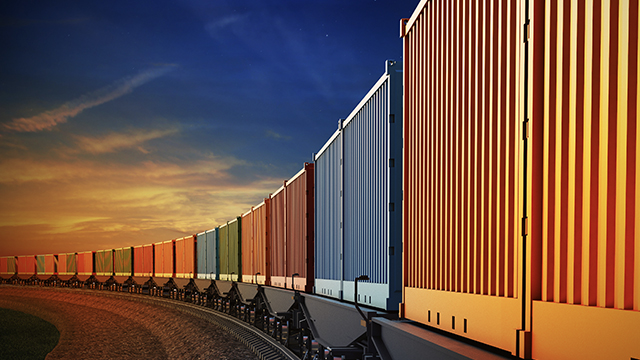[Instrumental Music Begins]
T.J. Thornton:
Hello and welcome to Global Research Unlocked, where we discuss what's rising, from growth industries to rising risks and opportunities in global markets. I'm T.J. Thornton, Head of Product Marketing at BofA Global Research, and we're recording this episode on Tuesday, July 22, 2025.
We've seen some very good success among fast casuals, but also among casual diners who have launched value combos at price point similar to what we might see from a traditional fast food restaurant. $10.99 gets you a burger, fries and a drink. Those are very compelling to consumers because there's so much food as opposed to in spite of it.
Restaurants have faced a tougher environment over the last couple years as the post-COVID boom faded, and consumers faced inflation rates at restaurants that were even higher than the overall inflation rates they were dealing with. We've also had a few well-known growth concepts within restaurants face challenges as same-store sales growth turned negative in some cases, leading to questions about whether the categories or concepts could be turned around. Today we're joined by Sara Senatore, U.S. Restaurant Analyst at BofA Global Research, and we'll be discussing these questions and more. We'll even get into labor constraints and whether AI and tech could be able to alleviate them. Thanks, Sara, for joining us.
[Instrumental Music Ends]
Sara Senatore:
Well, thanks for having me.
T.J.:
Sara, we hear a lot about how the travel economy has slowed over the last six to 12 months, probably a function of the consumer pulling back on some discretionary purchases and also some payback from strength after COVID. Are we seeing some of the same things in restaurants?
Sara:
I think actually the dynamic is quite similar in the sense that for airplanes, for example, we know that premium cabin is outperforming the main cabin. We're seeing something similar among restaurants, where higher-ticket restaurants are actually outperforming some of the lower-value-position restaurants, which historically we really haven't seen when there's stress in the economies. It really is a function of what I'll characterize as a bifurcated or two-speed economy where we're seeing more pressure on lower-income consumers than on higher-income consumers. The net of that is actually the industry as a whole doesn't look that different from what it has historically. It's just the complexion and the underlying dynamics have changed.
T.J.:
Sara, you've highlighted some weakness in quick service restaurants, which historically have been resilient. They offer fairly cheap meals, they've acted somewhat like staples, but did these companies raise prices to the point where value just isn't as compelling for the consumer anymore and people are finding better options in casual dining or elsewhere?
Sara:
I'll start by saying they're not helped by their income skew. So we do know for restaurants as a whole, we know that upper-income consumers do account for a bigger share of spend for restaurants and they do for say, food at home, but we also know that it looks different across different restaurant concepts. QSRs (quick service restaurant) do skew to a lower-income consumer, and that's certainly been pressuring demand more than what we might see for fast casual or casual dining. But to your point, they also haven't done themselves any favor in terms of the pricing that they took immediately after COVID. There were a couple years where inflation was quite high. Their own input costs were also inflating, and we were seeing some of these fast food restaurants take high-single-digit, 7% price and then another 10% price, and that really was something that narrowed that gap, if you will, between them and higher-price options. This year, we've seen pricing come down across the board, but we know that QSRs are still pricing in line with the industry. While the gap isn't narrowing further, it's also not widening back out. They're not improving their relative value; it's stable at this point, and we know for the fast casuals, for example, they are improving relative value by taking less price than their fast food or casual dining peers. The dynamic is a little bit better, but it still hasn't returned to where we would expect to see the relative value proposition sit.
T.J.:
There's another potential aspect here. I'm curious to get your view on whether it's had impact. We recently talked to Pete Galbo about a shift away from snacks, particularly unhealthful snacks, and I think that's all been compounded also by these price increases, higher prices and they're not good for you, and so people have been buying less of them. Have we seen any of that in quick serve or elsewhere within restaurants?
Sara:
I'll start by saying historically, when consumers shift towards eating more healthfully, the impact is much more pronounced on food at home than food away from home. When people go out to eat, they're looking for something indulgent. They're looking for something delicious. That tends to be the last place that they deprive themselves, if you will, and as a result, we really haven't seen a dramatic shift in the types of products that people are consuming. In point of fact, the daypart that has actually been under most pressure is breakfast, and that's really a function of being able to make it at home, pour yourself a bowl of cereal, that type of thing, as easily or more so than going and picking up a breakfast sandwich at a fast food restaurant. Snacking has still been one of the better growth dayparts, as has late night. This kind of 24-hour cycle of eating continues, and then when we think about the kinds of products that have really hit, they're not what anybody would consider low calorie. We've seen some very good success among fast casuals, but also among casual diners who have launched value combos at price points similar to what we might see from a traditional fast food restaurant: $10.99 gets you a burger, fries and a drink. Those are very compelling to consumers because there's so much food as opposed to in spite of it. The snacking dynamic isn't one that has really materialized in restaurants the way maybe it has at home.
T.J.:
Understood, and just a quick follow-up because yes, I am intrigued by the fact that you can get at a casual dining restaurant, something similarly priced with similar amount of food as you can at fast food. Are the companies doing well on those when you think about the margin contribution or are they not really making a whole lot of money and hoping to bring people in so that they order dessert and drinks and things like that that they actually can make money on?
Sara:
I would characterize these value offerings as probably gross margin dilutive. To your point, there is a lot of food for the money — expressly so, and though you tend to see a little bit less gross margin, a little bit less markup on the underlying cost of food. But these are still profit/dollar accretive and because there's so many fixed costs at a restaurant, if you bring in enough incremental customers, then they're actually going to enhance margins overall. Your gross margin might come down your food margin, but you're still using all the same fixed costs. You're still paying rent, you're still paying utilities. You might have to hire a little bit more in the way of labor, but not a lot — that's semi-fixed. I think the strategy has been to really engineer these products such that, while there might be some pressure on the food margin, over time, if you bring in these additional customers, you'll get very healthy returns on this business. Of course, you want them to be incremental. What you don't want is customers substituting this $10.99 meal for a $15 meal that they might have ordered otherwise, but we don't seem to be seeing that as much. In fact, some restaurants, some of the casual diners we're hearing from are actually talking about seeing more premiumization than they expect, more add-ons, more upsizing or choosing a dish with protein as opposed to without. We are seeing consumers spend on additions and add-ons and attachment even when they might be coming in initially for these value offerings. What you said is right: you do hope that people come in and attach some of these higher-margin desserts and drinks. They do seem to be doing that and we're seeing pretty good economics out of these deals for the most part.
T.J.:
Very interesting. I wanted to talk about fast casual, which for probably a few decades has been the hot thing in restaurants. As many of these concepts have outgrown the overall industry, they've taken share. One of these concepts is particularly near and dear to my heart — I was there last night in fact — but are we running out of gains for that segment or do you think that's still where the best growth can be found, and if there's still more growth and it's faster than the industry, where does this share come from?
Sara:
Yeah, when we look at the data for the industry as a whole, we're not really seeing a deceleration in growth. To the contrary, if I look at the last couple of years, fast casual has continued to take market share or share of wallet from the overall restaurant industry, from other segments within the restaurant industry. One of the things that we look at in particular is how is the fast casual segment comparing to the casual dining segment? Because historically fast casual has taken the most share from full-service restaurants, and if you think about it, this makes sense. They are effectively offering similar quality or sometimes some people would argue better, sounds like you might argue better for at least one of these concepts, and they're doing so historically at a lower price point and with faster service, which we've seen over time has been an unmitigated trend, which is people are shifting to more limited service. They like that control over the experience, they like the speed, nobody's going out to lunch anymore and sitting down with their coworkers. Everybody's running and getting something fast and coming back. We're all on the go, we're all pressed for time. Limited service continues to take share and fast casual within that takes share. What we have seen over the last couple years is its traditional QSRs that have lost some market share or share of wallet. Again, some of this has to do with the fact that growth by the lower-income consumer in restaurant spending has been slower than middle and higher income, but I do think we've also seen some pretty compelling value at a fast casual. When I mentioned pricing, the industry as a whole has increased prices this year about 4% year over year. That's been true across traditional fast food. It's been true in casual dining. The exception has actually been fast casual, where we've seen price increases closer to 2% or 3%. And so these companies are leveraging the excellent unit economics that they have to really invest in value and offer a very compelling value proposition to consumers. I don't think we're anywhere close to this growth story being over, and I'll just close with this thought, which is that if I look at share of transactions, fast casual still only accounts for about 14% of total versus traditional fast food, which is 80%, and if we look at even share of sales, it looks a little bit different, but ultimately there's still a lot of growth left in the segment.
T.J.:
Thanks, Sara. I wanted to talk about the coffee category. Away-from-home coffee has outpaced the restaurant industry and that's despite the fact that per capita coffee consumption in the U.S. has been flat or down for decades. Why is it that the away-from-home coffee category has performed so well?
Sara:
We need to think of it as an experiential good. Younger consumers do value experiences. While it always feels like the first suggestion every budgeting article is that you cut out your morning coffee, that's actually the piece, the ritual, the habit that people take a lot of joy in, and so we know that people, while they're not consuming more in terms of the grams of coffee they might be consuming every year, and in fact to your point, it looks like it's flat or down depending on the year you're looking at, they are consuming a lot more of it out of home because they like that experience and they like the customization that they can get. Drip coffee, brewed coffee, even for the biggest coffee chain out there, it's maybe 15%, 20% of sales. There are some up-and-coming coffee shops that don't serve brewed drip coffee. They're all espresso-based beverages. They're all these really customized and innovative beverages that have coffee as their energy source, really about the kinds of toppings and add-ons and dairy and non-dairy milks that can be included, and this idea of both a habit that you get into in the morning — you get your coffee on the way to work — but also the appeal of the customization and being able to do or have something that is special to you is really compelling, and we do see that the affinity for away-from-home coffee increases the younger the consumer. While some of these coffee shops have actually been around for decades, we're seeing that the preference actually stronger the younger the consumer, so younger cohorts, Gen Zs, for example, have a stronger affinity for a lot of these brands than their Millennial or Gen X or Boomer counterparts. I think this demographic dividend is what's going to continue to pay off for the category.
T.J.:
Understood, and based on my own experience, I would put Gen Alpha in there as well. I've got a couple of those. They're big fans of chain coffee drinks. Of course, they're not coffee. They’re other things. Meanwhile, I have my Dutch coffee maker at home and never order coffee away from home really, but I wanted to talk about immigration. I guess during COVID, labor availability was a big issue for restaurants. Of course, that's gotten easier now, but it seems like we may be talking about that again. Just yesterday, our econ team lowered payroll growth estimates for this reason, less immigration means less job growth, but it seems like the impact could be greater for restaurants that do overindex to immigrant labor. Do you see this as an issue for the industry when it comes to staffing restaurants and could it even impact demand if there are fewer consumers for these restaurants?
Sara:
The throughline obviously is that very much depends on the type of restaurant or segment. I'll start by saying in aggregate, we know that the restaurant industry does have more or higher share of the employment is immigrants and recent immigrants than for the economy as a whole. From a labor perspective, absolutely. I think this is an industry that is at risk or vulnerable to shrinking labor supply of immigrants. What I would say from a demand side though is that, again, when you think about the employees of the restaurant industry, they tend to be lower-wage employees. There's often a view in traditional fast food that your workers are your customers. That may not be the case as you go higher up on the price point. It's not to say that some of these casual diners don't cater to lower-income households. Some of them are quite big and so they all serve everybody. A lower-income consumer might use a casual diner for special occasions, whereas a higher-income consumer might just use that same casual diner for more of a home meal replacement or a convenience occasion. But broadly speaking, the labor force is going to be affected pretty meaningfully, at least relative to the economy as a whole. The demand side will really be contingent on what your core customer looks like. I haven't painted a really rosy picture for traditional QSRs, but, again, to the extent that that's the segment that has a bigger share of its customer base coming from lower-income consumers, lower-wage workers, that's probably where you would expect to see the greatest impact on demand.
T.J.:
Okay, and final question, and it's related. We often talk about how AI and automation can alleviate some labor shortages. How are restaurants using technology, including AI, and in what aspects of the business? And I guess again relating to the question about the potential decline in availability of workers, could that be an outlet?
Sara:
We saw during COVID a real labor shortage. A lot of people did not want to work in the hospitality industry for obvious reasons, and so we saw a spike in wages. One point in late 2021, we saw wage inflation in the mid-teens for the restaurant industry. We did see inflation in wages broadly, but it far outstripped what we were seeing in the economy as a whole. And in response, that's really when we saw proliferation of technology solutions. Anybody who didn't have digital-ordering capabilities — rule them out, whether it's a kiosk or a mobile order or a desktop ordering. We saw some of these, for example, traditional QSRs go from 0% digital ordering to 30percent digital ordering over the course of a couple of years, and that really was a function of this shift in labor availability. Digital ordering basically allows you, right, to take more orders with less labor, which is what we're seeing about technology and AI in general, which is to make the labor that you do have more productive. For example, with AI, there have been some test cases where the speaker box at a drive-through is using AI and talking back and forth with the customer. That is more, I would say on the margin. Where we're really seeing AI come into play is in predictive analytics, essentially helping a kitchen anticipate when there's going to be a big burst in demand and get ahead of that. Maybe by prepping the right ingredients or by starting to cook a protein that takes 10 or 15 minutes to cook and doing it in advance of the demand actually coming in because the software is telling them that this demand is going to come in and if they have these wings prepared five to 10 minutes early, they can cut the production time in half. What we're seeing really is this adoption of technology as a way to not replace labor per se. We're not hearing about restaurants laying people off. What we're hearing is that they're bringing in technology to make the existing workers more productive and to improve their experience too. Something like cutting vegetables or coring fruit, things like that maybe aren't the most fun part of working at a restaurant. These are things that can be outsourced as well, so there's the predictive analytics and then there's some of the streamlining equipment that we're seeing, and both are meant to make the job easier, better, more accessible, without a lot of training for the employees, as well as to support productivity, enhance the customer experience and, of course, in the end, contribute to profitability.
T.J.:
Well, Sara, really appreciate your thoughts. That was a great discussion.
Sara:
Thank you, T.J.
[Instrumental Music Begins]
T.J.:
Within restaurants, we're also seeing evidence of a bifurcated economy with strength in higher income and relative weakness in lower income. Quick service restaurants took more price over the last few years than other segments, which has added to the challenges for some of these concepts, but more recently, they've been forced to focus on value again. The issue, though, is that fast casual took less price over the last several years, which has made their value proposition look even better. Sara remains bullish on fast casual, which still only accounts for about 14% of restaurant transactions versus closer to 80% for quick service, and she sees room for further share gains. And the experiential aspect of coffee remains compelling for people. It's one of the reasons they've had a hard time removing these drinks from their budgets. While it's still a bit early to see much impact from immigration, restaurant labor could face some meaningful challenges from changes in immigration policy. Some portion of this could be alleviated with technology, which can help to better understand demand and even automate some tasks. Thanks for joining.
[Instrumental Music Ends]
Announcer:
"Bank of America" and “BofA Securities” are the marketing names for the global banking businesses and global markets businesses (which includes BofA Global Research) of Bank of America Corporation. Lending, derivatives and other commercial banking activities are performed globally by banking affiliates of Bank of America Corporation, including Bank of America, N.A., Member FDIC. Securities, trading, research, strategic advisory and other investment banking and markets activities are performed globally by affiliates of Bank of America Corporation, including, in the United States, BofA Securities, Inc., a registered broker-dealer and Member of FINRA and SIPC, and, in other jurisdictions, by locally registered entities.
©2025 Bank of America Corporation. All rights reserved.
[End of transcript]
.jpg)



